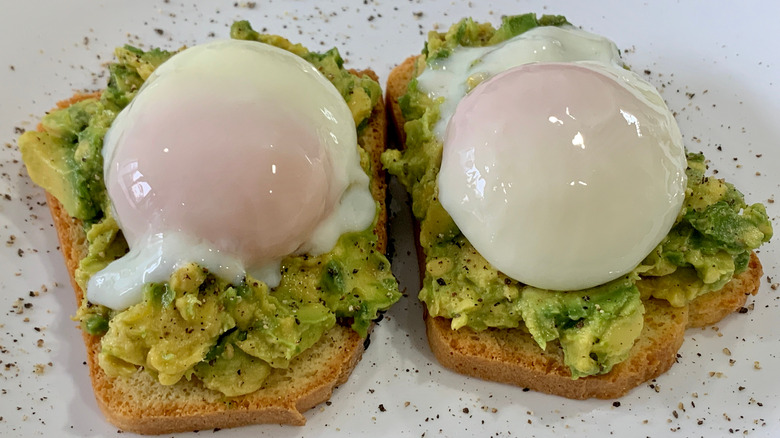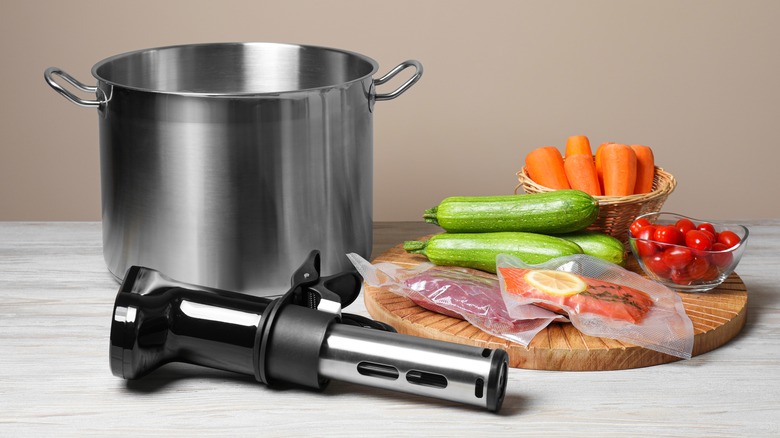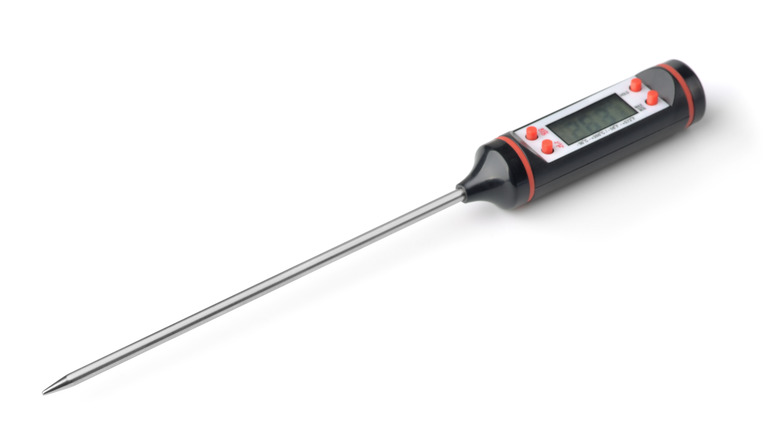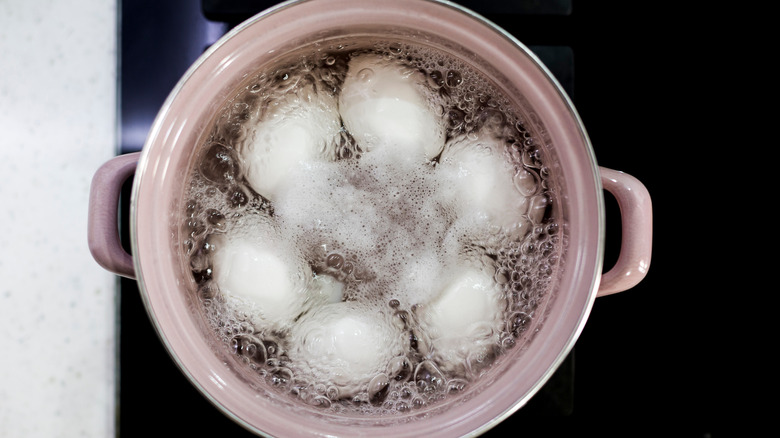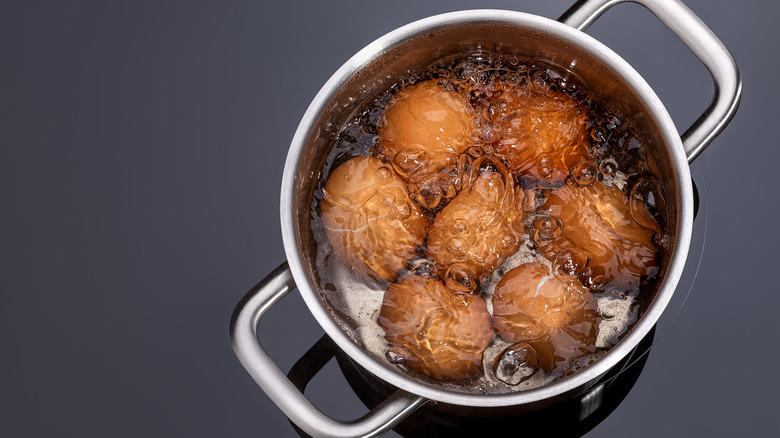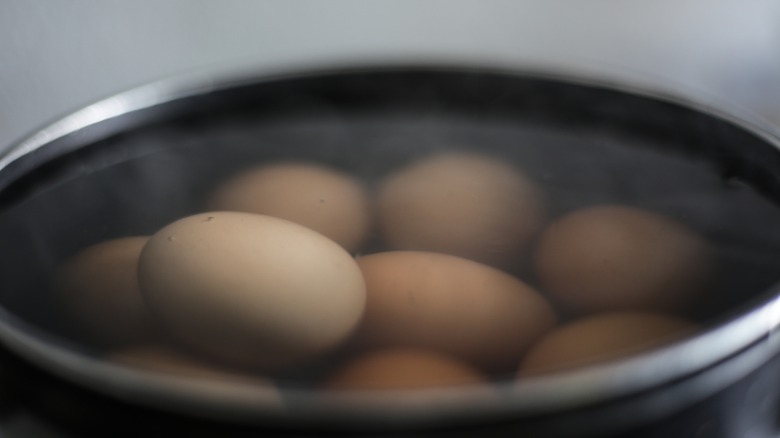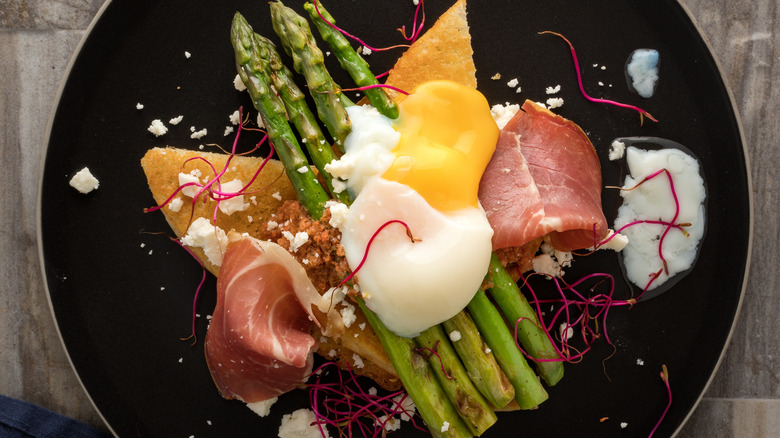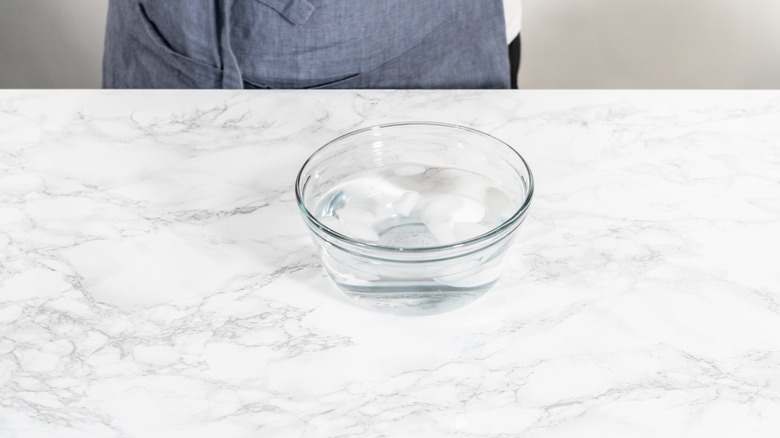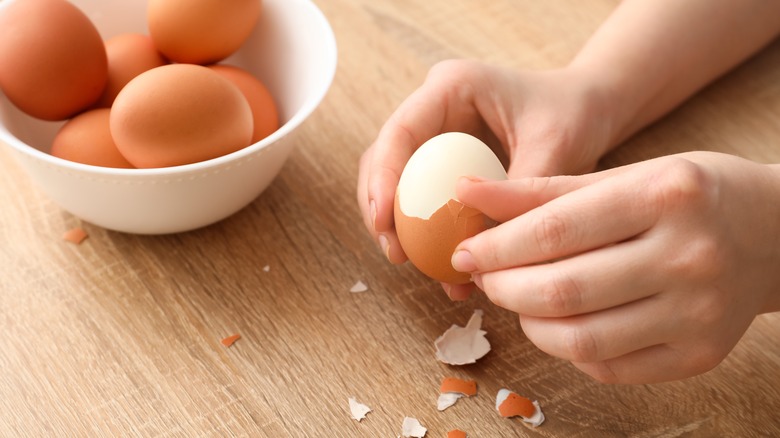8 Tips To Master Sous Vide Eggs
Despite the intimidating name, sous vide is actually a simple, hands-off cooking method renowned for its consistent results, usually perfectly cooked proteins. French for "under vacuum," sous vide is the process of putting food in a vacuum-sealed plastic bag and cooking it by submerging it in temperature-controlled water. The sous vide machine's heated coils warm the water to the precise temperature of your choosing. Though they were typically once found only in the kitchens of high-end professional chefs and culinary schools, where I learned the technique, in recent years, sous vide machines have become an item commonly found in many home kitchens.
Precision is what sets sous vide apart from other cooking techniques. The immersion circulator keeps the temperature constant with no variation. The water is set to your desired temperature so the food never rises above it. If you follow directions for time and temperature accurately, sous vide makes it very difficult to overcook your food, another reason for its popularity.
Though meat and poultry are often the first foods that come to mind with sous vide cooking, eggs are the perfect food for this cooking technique. Because they cook quickly, eggs are easy to overcook with other cooking methods. Sous vide makes perfectly cooked eggs possible, no matter how you prepare them. Whether you love a poached egg with a deliciously runny yolk for your eggs Benedict or a hard-boiled egg with a firm, solid center to slice for a salad, sous vide is the way to go.
Use the right tools
With any cooking technique, it's important to stock your kitchen with the appropriate tools for the job. Sous vide is no different. To start, you'll need either an immersion circulator or a sous vide machine. If you choose an immersion circulator, you'll also need a large pot to attach the circulator to. The immersion circulator is a tall, cylindrical device that contains the heating elements that will warm the water and a circulator that moves the water around the pot. Choose a pot large enough to accommodate the food you're cooking and the immersion blender. You can also use a large plastic container for sous vide cooking.
A sous vide oven is a self-contained countertop appliance that is usually about the size of a microwave. It contains all the elements of the immersion circulator plus an area for a water bath built-in for convenience.
You'll need a few additional tools to cook sous vide eggs. Dropping eggs into a pot of water can crack the shells, making a mess of your sous vide setup. To be safe, you'll need a slotted spoon, tongs, or a spider strainer to gently lower the eggs into the water. If you plan to cook your eggs in a bag, you'll need sturdy, resealable plastic bags or a vacuum sealer system. You'll also need a large bowl for a water bath to stop your eggs from cooking when you remove them from the hot water.
Choose the right temperature
Choosing the right temperature is the key to success when cooking sous vide. No matter what you're cooking, if you cook it at the right temperature and for the correct length of time, sous vide will likely positive yield results. Cooking eggs correctly can be tricky with other cooking methods. Overcooking them can make them less than desirable, and it's easy to do. If you've ever cracked a boiled egg only to find a dark green ring around the yolk or slid your fork into a poached egg to find no runny yolk, you've been a victim of overcooked eggs. Sous vide can help you avoid that.
Poaching eggs the conventional way involves heating water to a temperature between 160 F and 180 F and creating a vortex of swirling water to slide the cracked eggs into. It's difficult to maintain a precise temperature with stovetop cooking, and if the water temperature increases during cooking or you leave your eggs in the water too long, you have inadvertently overcooked your eggs.
With sous vide, there's no fear of cooking your eggs at too high a temperature. Once the temperature is set, it will remain at that temp as long as you're cooking. To poach eggs, simply cook your eggs in the shell at 145 F to achieve the perfect poach. For a soft boil, add the eggs to 167 F water, and for hard-boiled eggs, the water temperature should be between 165 F and 169 F.
Don't cook too many eggs at once
The phrase "don't put all your eggs in one basket" can easily be applied to sous vide cooking. If you've ever boiled a large amount of eggs, like the dozens required for a proper Easter egg hunt or a large batch of deviled eggs, you've probably learned this lesson the hard way. Attempting to cook too many eggs at one time in the same pot can be disastrous. If the eggs are crowded in the pot, the pressure from the boiling water can cause the eggs to shift and crash into each other. This can cause the eggshells to crack, making a mess in your pot and potentially damaging your sous vide machine if you cannot remove the tiniest bits of eggshell from the water.
Sous vide is a gentle cooking method. There's typically little to no movement in the pot because the water temperature is never high enough to boil, but cooking too many eggs sous vide style can cause a similar outcome. In a crowded pot, it's easy for eggs to crack from bumping into their neighbor, no matter how gently. Eggs should line the bottom of your pot in a single layer with a bit of space to accommodate a little movement. For added protection, you can vacuum seal your eggs in a plastic bag before adding them to the water. Removing the air from the bags leaves space between them so they are less likely to crack.
Watch the water level
Sous vide uses water to cook food evenly at low temperatures. Whether you're using an immersion circulator or fully contained sous vide water bath machine, using the right amount of water is crucial.
When you're boiling eggs the conventional way, you only need enough water to cover the eggs, but both types of sous vide appliances require a generous amount of water. Some sous vide machines can hold as much as 5 gallons of water. If you're using an immersion circulator, the amount of water you need will depend upon the size of the pot you use to cook. The goal is to use enough water to cover the food fully, but your work doesn't end there.
You also need to make sure the amount of water you use will last the entire length of your cooking time. Sous vide is done without a lid, so some water may evaporate as you cook. You can cover your pot or sous vide machine with plastic wrap or a lid to prevent any evaporation. The heating coils on the immersion circulator should always be fully covered by water. You need at least 2.5 inches of water to sous vide properly.
Sous vide water ovens make monitoring water levels simple. Most are marked with minimum and maximum lines to help you add and maintain the correct amount of water. Follow the machine's instructions to make sure you get it right.
Master the water displacement method
In order to cook properly, food has to be fully submerged in water in a pot or a sous vide machine. Some foods can rise to the surface once they're placed in the water. That can be problematic in a couple of ways.
If any portion of the food rises above the surface of the water, it's in danger of not cooking all the way through. Chelsea Cole, author of "Everyday Sous Vide," told Tasting Table that food that is not fully submerged is also in danger of bacteria growth. When left at temperatures between 40 F and 140 F any bacteria present in food can multiply rapidly.
To prevent this, it's critical that your food remains fully submerged. If you're cooking eggs in a plastic bag, any air left in the bag will create air bubbles that will lift the bag to the surface. There's a simple trick to keeping the bag submerged, even if you don't have a vacuum sealer.
The water displacement method will keep eggs submerged as they cook. It removes air from the bag before you seal it. Place your eggs in the plastic bag. Place the bag in the sous vide machine or the pot. As you lower the bag in the water, the pressure from the water will force excess air out. Seal the bag before the water reaches the top. With little or no remaining air trapped inside, your bag of eggs should stay fully submerged.
Watch the time
Sous vide has a reputation for making it difficult to overcook foods, and while that's true, it's essential to pay close attention to the amount of time you leave your food, especially eggs, in the sous vide machine or pot. In many recipes, there's some wiggle room when it comes to cooking times. In fact, it's not uncommon to find cooking ranges in recipes to give cooks a general sense of how long food should cook. Cake recipes often read bake for 10 to 15 minutes. A stir-fry recipe might direct you to sauté the dish for 10 to 12 minutes. This is to accommodate slight variations in oven temperatures and other factors that might affect how food cooks. With sous vide, temperature variations are nonexistent. Once it's set, the temperature remains the same throughout the entire cooking process, producing perfect results every time as long as the timing is also right.
Perfect poached eggs should have soft but set whites with a runny yolk. You can achieve this with sous vide by adding the eggs, in their shell, to 145 F water for one hour. For soft-boiled eggs with firm whites and a thick, liquid yolk, cook them for 13 minutes in 167 F water. Hard-boiled eggs require a cooking time of one hour in 167 F water for extra firm whites and a solid but still moist yolk.
Always use a water bath
Ice water baths are used in cooking to quickly reduce the temperature of food, typically after it has been blanched or partially cooked. It involves transferring food from hot or boiling water to a bowl full of ice water for a period of time, usually around 15 minutes. The sudden temperature change immediately stops the food from cooking, and the lower temperature makes the food safer to handle.
Shocking eggs in an ice water bath is the standard procedure when poaching or boiling eggs the conventional way. The ice water bath lowers the temperature of the eggs so they don't overcook, and it can also make them easier to peel. For sous vide eggs, the ice water bath interrupts the slow cooking process and makes it easy to serve eggs at the perfect temperature when you're cooking several eggs or want to save them for later. Even with sous vide's gentle, precise cooking, shocking the eggs in ice-cold water eliminates any chance of overcooking.
When your eggs are done cooking in your sous vide machine or pot with an immersion circulator attached, use a slotted spoon or tongs to carefully place them in an ice water bath. To serve the eggs immediately, let them stay in the water bath long enough for them to cool down so they're not too hot to handle. You can enjoy them later by adding them back to the sous vide machine or pot for 10 minutes at 130 F.
Peel the eggs properly
The final step in mastering sous vide eggs is getting them safely out of their shell. Peeling eggs of any kind can be tricky, but sous vide eggs, particularly when they're poached or soft-boiled, can require a little more attention. Both poached and soft-boiled sous vide eggs have whites that are lightly set not firm, making it more difficult to peel the shell away smoothly and without damaging or breaking the egg.
For poached eggs, you only need to remove enough of the shell to create an opening for you to spoon or pour your poached egg out. To do this, gently crack the larger end of the shell and peel the shell away with your fingers. If you're serving your soft-boiled egg in an egg cup, place the egg in the cup and use a small spoon to gently crack away the top part of the shell to create an opening large enough to spoon out the gooey inside or for dipping your toast or bacon into.
Peel hard-boiled sous vide eggs the same way you would a regular boiled egg. Crack them on one end and then gently roll the eggs under your palm, applying enough pressure to crack the surface of the shell all over without crushing the egg. Run the egg under cold water and peel the shell away.
